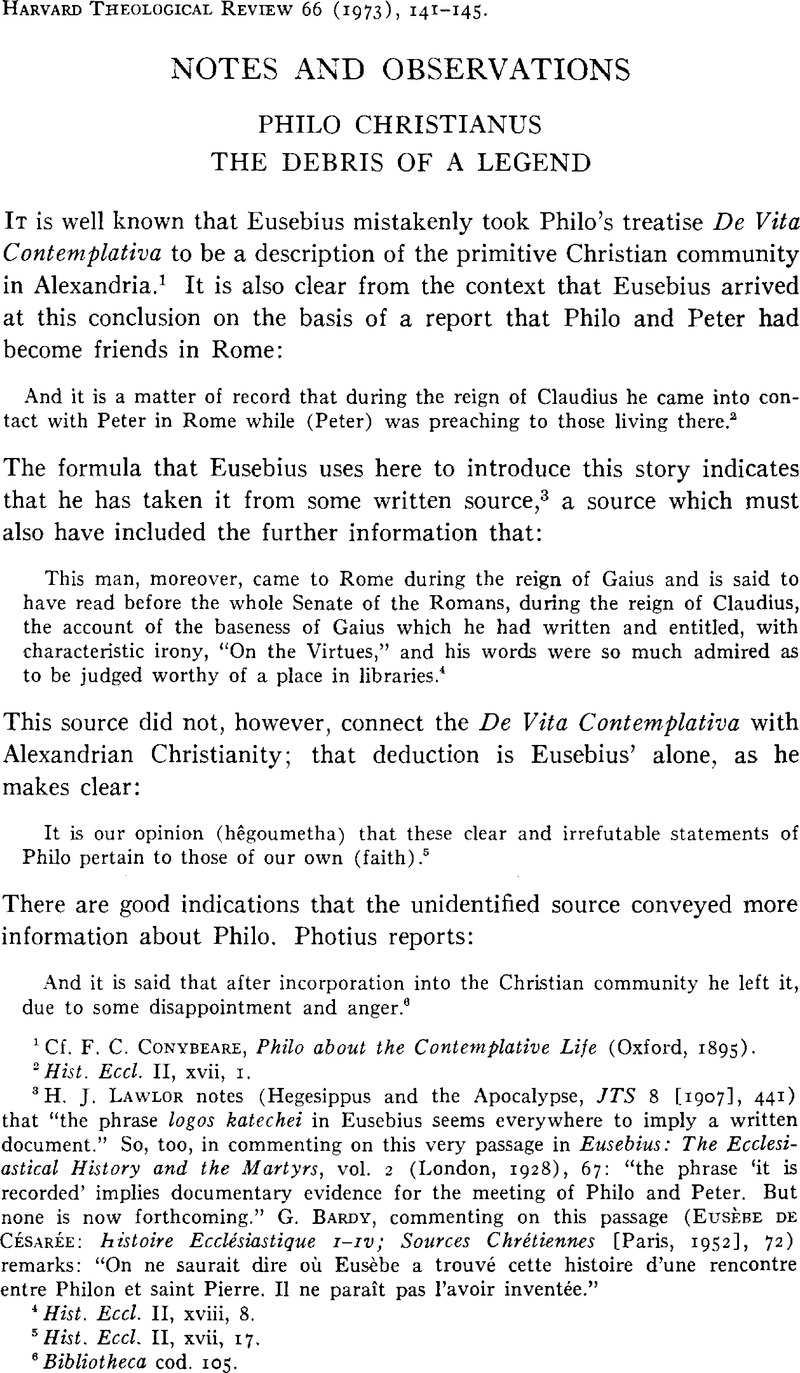Article contents
Philo Christianus: The Debris of a Legend
Published online by Cambridge University Press: 10 June 2011
Abstract

- Type
- Notes and Observations
- Information
- Copyright
- Copyright © President and Fellows of Harvard College 1973
References
1 Cf. Conybeare, F. C., Philo about the Contemplative Life (Oxford, 1895)Google Scholar.
2 Hist. Eccl. II, xvii, 1.
3 Lawlor, H. J. notes (Hegesippus and the Apocalypse, JTS 8 [1907], 441)Google Scholar that “the phrase logos katechei in Eusebius seems everywhere to imply a written document.” So, too, in commenting on this very passage in Eusebius: The Ecclesiastical History and the Martyrs, vol. 2 (London, 1928), 67Google Scholar: “the phrase ‘it is recorded’ implies documentary evidence for the meeting of Philo and Peter. But none is now forthcoming.” Bardy, G., commenting on this passage (Eusèbe de Césarée: histoire Ecclésiastique I-IV; Sources Chrétiennes [Paris, 1952], 72Google Scholar) remarks: “On ne saurait dire où Eusèbe a trouvé cette histoire d'une rencontre entre Philon et saint Pierre. II ne paraît pas l'avoir inventée.”
4 Hist. Eccl. II, xviii, 8.
5 Hist. Eccl. II, xvii, 17.
6 Bibliotheca cod. 105.
7 Hist. Eccl. III, xxiii (M.P.G. 67, 444).
8 Hist. Eccl. II, iv, 2. Bardy (op. cit., 56) queries: “On se demande comment Eusèbe a pu dire de Philon qu'il était ‘des nôtres’ sinon parce qu'il annexe volontiers les Juifs au Christianisme.” But this is hardly an acceptable explanation, since Eusebius nowhere else shows any such disposition.
9 Th. Zahn, Acta Joannis [Erlangen, 1880], 110–12. A curiously neglected legend about Philo which not even Harnack alludes to.
10 Id., liii. Zahn goes on to say: “Ein wenig besser motivirt ist die Gestalt des jüdischen Schriftgelehrten Philo ‥‥ und es wäre keine ganz verächtliche Idee gewesen, den jüdischen Logoslehrer mit dem Christlichen zusammenzubringen.” But (p. liv) “es ist nur der Name ‘Philo, der gelehrte Jude” welcher diese Erzählung des Prochorus mit Geschichte order Sage verknüpft.”
11 Praefatio in Libros Salomonis (M.P.L. 28, 1308)
12 Cf. Lagrange, M. J., Histoire ancienne du Canon du Nouveau Testament (Paris, 1933), esp. 74, fn. 3Google Scholar; Chapman, J., L'Auteur du Canon Muratorien, RevBen 21 (1904), 240–64Google Scholar, esp. 247–49.
13 In Hexaemeron I, vii. Greek text in Preuschen, E., Antilegomena (Giessen, 1901), 60Google Scholar.
14 M.P.G. 89, 860.
15 E.g., Hippolytus (M.P.G. 10,793); Origen (M.P.G. 12,332); Eusebius (M.P.G. 22,1200); Athanasius (M.P.G. 26, 1406.1427); Cyprian (M.P.L. 4,108); Lactantius (M.P.L. 6, 497); Ambrose (M.P.L. 15, 1372–73); Augustine (M.P.L. 41,554; 42, 278).
16 Praeparatio Evangelica I, xi, 7.
17 Reference here is to the Peri tês môuseôs kai Jêsou sumphônias; cf. Eusebius, Hist. Eccl. VI, xix, 10.
18 Hist. Eccl. IV, xxii, 8.
19 Such as the account of James the brother of the Lord (Hist. Eccl. II, xxiii, 4–18).
20 Hist. Eccl. IV, xxii, 1–2.
21 Hist. Eccl. IV, xxii, 8–9.
22 Second Century Christianity (London, 1957), 57.
23 Inter alios Seneca (Jerome, De Viris Ill. 12); the Sibyl (Ps. Justin, Exhortatio ad Graecos 37); Gundaphorus (Acta Thomae 17–27); Augustus Caesar (Vat.Pal. Ms 227); Tiberius Caesar (Cura Sanitatis Tiberii); Tryphaena of Thrace (Acta Pauli et Theclae 27–43); etc. Where the personality was not appropriated, the physiognomy sometimes was; cf. H. P. L'Orange, Plotinus-Paul, Byzantion 25/27 (1955–57). 473–85.
- 2
- Cited by


